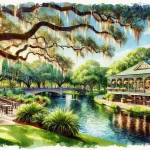New Orleans is a city deeply rooted in history, with a diverse cultural backdrop interwoven into its very essence. From its colonial beginnings to its pivotal role during World War II, the city’s historical attractions offer a captivating journey through time, inviting visitors to immerse themselves in the narratives that have shaped this vibrant metropolis.
In This Article
TL;DR
- New Orleans boasts an array of historic sites reflecting its unique blend of French, Spanish, African, and American influences.
- Exploring these attractions provides insights into the city’s intricate past and enduring cultural legacy.
- Visitors can experience everything from colonial architecture to wartime narratives, mystical traditions, and plantation histories.
The French Quarter: Heart of New Orleans History
The French Quarter, or Vieux Carré, is the beating heart of New Orleans‘ historical legacy. Established in 1718 by French colonists, this iconic neighborhood exudes an old-world charm that transports visitors back in time. St. Louis Cathedral, a magnificent example of French Renaissance architecture, stands as a testament to the city’s Catholic roots and colonial past. Nearby, the Cabildo and the Presbytère, two Spanish colonial buildings, now house museums that showcase the city’s rich cultural heritage.
Preservation Hall, a beloved music venue, pays homage to the city’s jazz traditions, offering a glimpse into the vibrant musical culture that has captivated audiences worldwide. Strolling through the French Quarter’s narrow streets, visitors can’t help but be enchanted by the wrought-iron balconies, colorful buildings, and the lingering scent of beignets and chicory coffee.
The National WWII Museum: A Modern Historical Journey
While New Orleans is renowned for its colonial and antebellum history, the city also played a pivotal role during World War II. The National WWII Museum, a world-class institution, offers an immersive and educational experience that brings this pivotal era to life. Visitors can explore exhibits like the “Road to Tokyo” and “Road to Berlin,” which chronicle the Allied campaigns in the Pacific and European theaters.
One of the museum’s highlights is the Higgins Boats exhibit, showcasing the innovative landing craft designed and built in New Orleans, which played a crucial role in amphibious assaults during the war. Through interactive displays, personal accounts, and artifacts, the museum pays tribute to the sacrifices and triumphs of the Greatest Generation, while also highlighting New Orleans’ strategic importance during the conflict.
Historic Voodoo Museum: Exploring Mystical Heritage
New Orleans’ history is inextricably linked to the mystical practices of Voodoo, a spiritual tradition with roots in West African and Caribbean cultures. The Historic Voodoo Museum, located in the heart of the French Quarter, offers a fascinating glimpse into this enigmatic world. Visitors can explore exhibits that provide insights into the origins and rituals of Voodoo, as well as its influence on New Orleans’ cultural identity.
From intricately crafted Voodoo dolls to altars adorned with symbolic offerings, the museum provides a window into the beliefs and practices that have been woven into the fabric of the city’s heritage. Guided tours and knowledgeable staff offer insights into the complex history of Voodoo, shedding light on its role in shaping the unique cultural landscape of New Orleans.
The Role of Plantations in New Orleans’ History
No exploration of New Orleans’ history would be complete without acknowledging the profound impact of plantations on the region’s socio-economic and cultural narratives. Two plantations, in particular, stand out as must-visit destinations for history enthusiasts: Whitney Plantation and Oak Alley Plantation.
Whitney Plantation, a former indigo and sugar plantation, offers a sobering and educational experience that sheds light on the harsh realities of slavery. Through powerful exhibits and guided tours, visitors can gain a deeper understanding of the lives of enslaved Africans and their enduring legacy in shaping the region’s history.
Oak Alley Plantation, on the other hand, is a stunning example of Greek Revival architecture, with its iconic oak-lined path leading to a grand antebellum mansion. While the plantation’s beauty is undeniable, it also serves as a poignant reminder of the complex and often painful history of the American South.
Address: 3645 Highway 18, Vacherie, LA 70090
Phone: (225) 265-3300
Hours: Daily 9AM-5PM
Whitney Plantation
Address: 5099 Hwy. 18, Wallace, LA 70049
Phone: (225) 265-3300
Hours: Daily 9AM-5PM
Preservation Efforts and Their Impact
New Orleans’ commitment to preserving its historical legacy is evident in the numerous preservation efforts undertaken by local organizations and authorities. The city’s historic preservation laws have played a crucial role in safeguarding iconic structures and neighborhoods, ensuring that future generations can experience the city’s rich heritage.
One notable success story is the preservation of the Pontalba Buildings, a pair of historic apartment buildings flanking Jackson Square in the French Quarter. These iconic structures, once in disrepair, have been meticulously restored and now house museums, shops, and residences, serving as a testament to the city’s dedication to preserving its architectural treasures.
Another example is the Gallier House, a beautifully preserved 19th-century townhouse that offers a glimpse into the lives of a wealthy Creole family during the antebellum era. Through careful restoration and interpretation, the Gallier House provides visitors with a tangible connection to New Orleans’ past, fostering a deeper appreciation for the city’s cultural heritage.
Engaging with History: Tours and Events
To fully immerse oneself in New Orleans’ historical tapestry, visitors can partake in a variety of tours and events that bring the city’s past to life. Ghost tours, led by knowledgeable guides, weave tales of haunted mansions and eerie encounters, adding a touch of mystery and intrigue to the experience.
Heritage walks, often conducted by local historians, offer a more in-depth exploration of the city’s architectural and cultural landmarks, providing insights into the stories behind the buildings and neighborhoods. For those seeking a unique perspective, riverboat cruises along the Mississippi offer a chance to witness the city’s skyline from the same vantage point as its earliest settlers.
Annual events like the French Quarter Fest and the Creole Tomato Festival celebrate the city’s culinary and cultural traditions, inviting visitors to immerse themselves in the sights, sounds, and flavors that make New Orleans truly unique. These festivals not only provide entertainment but also serve as living museums, preserving and showcasing the city’s rich heritage.
Safety and Accessibility in Historical Areas
While exploring New Orleans’ historical attractions, visitors can rest assured that safety measures are in place to ensure a secure and enjoyable experience. Many of the city’s major historical sites have implemented enhanced security protocols, including surveillance cameras and on-site security personnel.
Additionally, efforts have been made to improve accessibility for visitors with disabilities. Ramps, elevators, and audio guides are available at many locations, ensuring that everyone can fully appreciate the city’s historical treasures. It is advisable to check individual site websites or contact them in advance to inquire about specific accessibility features and accommodations.
Supporting Local Heritage: Community and Tourism
The preservation and promotion of New Orleans’ historical heritage are not solely the responsibility of institutions and authorities; visitors play a crucial role in supporting these efforts through responsible and respectful engagement. By patronizing local businesses, attending cultural events, and participating in guided tours, visitors contribute to the economic sustainability of the city’s historical attractions.
Moreover, many tourism businesses and preservation groups have formed partnerships to enhance visitor experiences while also promoting the conservation of historical sites. These collaborations often involve educational initiatives, fundraising efforts, and the development of sustainable tourism practices that prioritize the protection of New Orleans’ cultural and architectural legacies.
As you explore the historical wonders of New Orleans, remember to embrace the city’s unique spirit and respect the traditions that have shaped its identity. By engaging with the past and supporting local heritage, you not only enrich your own understanding but also contribute to the preservation of this remarkable city for generations to come.






